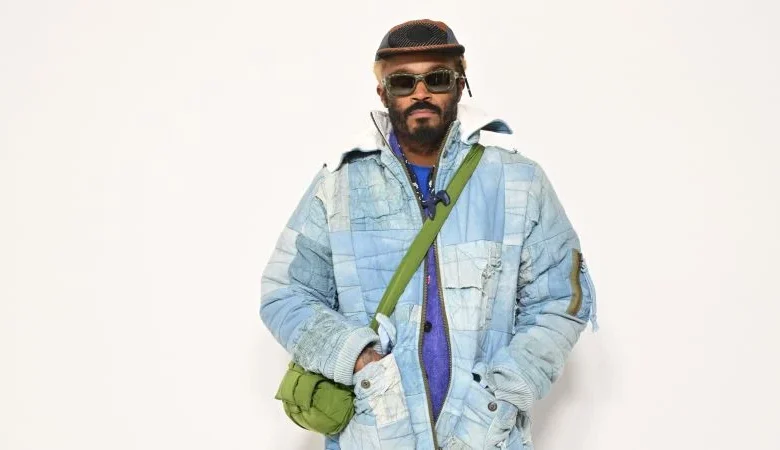After taking the footwear world by storm, sneaker don Salehe Bembury is stepping out on his own

Salehe Bembury is imagining what his career retrospective might look like. The lauded footwear designer, who is credited with spearheading Versace’s entry into the sneaker market, has no shortage of work to exhibit. From catwalk to high street, he’s designed for Yeezy, New Balance, Crocs, Puma, Moncler and more. However, he’s fantasizing about a “forbidden room” in the show; somewhere “you can see what I’ve worked on that no one’s known about.”
Yes, Bembury, despite his inimitable work, has ghost designed — and for big names too. He just can’t talk about it due to nondisclosure agreements. One day he might be able to spill the tea. But not today.
The 39-year-old designer confessed he forgot he’d mentioned this in his new book.
“Salehe: I Make Shoes” is the much-awaited art book telling the story of Bembury’s remarkable career to date. Combining interviews, essays, illustrations and candid photography, the book takes readers inside the niche and complex world of luxury sneakers. “I don’t think there are that many books that honor this space that we’re in — sneakers, hype culture,” he said.
“To any young designer that’s trying to figure out their path and trying to understand how to pivot or move or jump to the next gig, or deal with your uncertainty or your vulnerability — this book has that in there through my stories and through my experiences,” he added.
“This is a job of communication and millimeters.”
Salehe Bembury
Sneakers are a multibillion-dollar industry, though few designers are household names. The brand is generally king. Only a handful of exceptions have crossed into popular culture, Nike legend Tinker Hatfield chief among them. Bembury is heading that way.
Bembury came from the culture. As a kid in the ’90s, whether he was watching the NBA or “The Fresh Prince of Bel Air,” he looked at what was on people’s feet. He grew up in New York, a few blocks from the bootleg vendors on Canal Street, though he cherished the real deal too much to buy knock offs. He was drawn to Nike — Jordan 11s, the Presto, the Air Footscape — and the narratives it built around new releases. But he wasn’t tribal; he could still appreciate a sneaker like the AND1 Too Chillin, which broke the mold and made him look at footwear differently.
Bembury knew early that he wanted to design sneakers. The dream was for Nike. His parents were artistic, but when it came to his future, they nudged him toward a practical middle ground. He majored in industrial design at Syracuse University — a decision that ended up being “extremely helpful,” he reflected, “because this is a job of communication and millimeters.”
Since then, he’s been on what he calls a “utilitarian quest.” “I’m not only looking to make things that look cool, they need to work,” he explained. “Because if it doesn’t work, it’s art.”
Bembury got his first break in 2011, when he was hired by the innovation team at Cole Haan, which was owned by Nike at the time. With a mandate to experiment, he played around creating hybrid concepts in a “Willy Wonka chocolate factory of creative expression,” he writes. From there he jumped to footwear startup Greats, where more of his designs were released. He began participating in marketing and cultivating a following of his own. Then in 2015 the artist formerly known as Kanye West (now Ye) came calling.
The designer decamped to the West Coast to join Ye’s team, where he created military-style boots for Yeezy’s third and fourth collections.
As a boss “(Ye) was an extremely motivated, inspired one,” he recalled. “My job there was to be his pencil, bring his ideas to fruition and try not to get in his way.”
“Getting to learn from him and be kind of like a voyeur in that space was extremely educational,” he added. The designer found himself floating in new, influential circles —with fashion-forward artists like 2 Chainz and designers like the late Virgil Abloh. “Yeezy was kind of the doorway,” he said.
“During this period, anyone that worked with Kanye was then knighted with some kind of Kanye dust. That allowed me to step into the high fashion space and be respected and be listened to.”
But after leaving Yeezy in 2016, Bembury hit a rough patch. He freelanced for a while. With funds running low, he fired out a series of pitches to people on LinkedIn. One of them was Dean Quinn, then-design director of Versace.
“I’ve kind of omitted this part of the story as of late because people get a little too caught up in it, but I was actually on the toilet when I sent the message,” Bembury confided.
Bembury argued Versace was missing out by not tapping into the sneaker market, and that the strength of the brand would translate. (Gucci, in comparison, had been making sneakers since the ’80s.) Three days later, he writes, Donatella Versace emailed him with an invite to Milan. In September 2017, Bembury began reporting directly to her as head of sneaker design.
His biggest hit at Versace was the Chain Reaction, which pulled from the fashion house’s iconography, including a chunky sole that looked like a thick gold chain. They became a fixture at gigs and catwalk shows — on the runway and in the front row.
Bembury, meanwhile, was carving out creative freedoms of his own. His contract with Versace allowed him to engage in a limited number of collaborations with other companies. He chose Chinese sportswear company ANTA and New Balance.
Even more of his personality was on display: bright, high-contrast colorways and elaborate, high-tech sole construction on the ANTA SB-01 and New Balance Yurt.
On the latter he famously added a whistle to the heel. “Truthfully, I came up with the whistle before I even came up with the why,” he said. But he says he’s regularly sent videos of trail runners trying it out in the woods. “The consumer doesn’t know what they want until you show it to them,” Bembury added — “shout out (to) Steve Jobs.”
By the time he left Versace in 2020 he was vice president of sneakers and men’s footwear. As a fully-fledged independent designer with a following, Bembury entered his mercenary era, hired to flip brands on their heads, make them cool and widen their audience.
Crocs was a prime example: In 2021 he created the Pollex Clog, a swooping, ribbed riff on the classic Crocs silhouette. It had Bembury’s fingerprints all over it — literally, as the 3D design was an amalgam of the designer’s own finger and thumbprints. He’d been toying with a fingerprint as his hallmark, and as the first collaborator Crocs had allowed him to design a shoe from scratch, which “seemed like the perfect opportunity,” he said.
It exploded. They were for adults and kids; Marc Jacobs and the man or woman on the street. Bembury said people would DM him saying, “‘You’re the reason I’m wearing Crocs for the first time.’” Crocs execs took note (he re-upped his deal with the brand in 2023).
“The Crocs moment was a pivotal one,” said Bembury. “I had been living in this very niche hype streetwear space, and this was something that was meant for everybody.”
Bembury had transcended the sneaker bubble and proved his designs could bring new consumers to a brand. Even more companies wanted a piece of him: Clarks, Vans, Moncler. He designed outerwear for Canada Goose and cover art for rapper Wiz Khalifa. He doubled down in the mainstream sneaker market with a significant partnership with Puma.
Still, he didn’t accept all offers. The Wall Street Journal reported Bembury was approached by Nike — his childhood dream — a few years ago and he turned them down, citing the terms of the deal. “While I’ll say that is a factual moment, I don’t really care to speak about it beyond that,” said Bembury, who was unhappy this tidbit had “taken over the dialog.”
Even those who couldn’t get him were looking to him for inspiration. “I don’t want to be messy, but I had a designer from a company basically tell me that my work is the most seen stuff on their mood boards. That then helped me maybe confirm some speculation,” Bembury said.
Despite all evidence, the designer is uncomfortable with the idea he has clout. “I don’t know if there was a moment where I was like, ‘I’m the s—t,” he said. But he accepts he has “an audience,” one that he’ll need for his next venture — his own sneaker brand, Spunge, which launched in October.
“It’s time to execute everything I’ve learned.”
Salehe Bembury
The move is “long overdue,” he explained. “There are very few people within footwear that have been able to cultivate the audience that I have; had the success that I have. And it’s all under — was under, I guess — the title of a different brand. It makes complete sense that this person that has continuous success within a space to kind of venture out on their own.”
“It’s time to execute everything I’ve learned,” he added.
Spunge’s first model, Osmosis, retails for $150 and bridges sleek sports sneaker and rugged trail shoe, with colorways leaning toward the latter (Bembury is an outdoorsy guy). He says two more designs are “pretty much ready to go” and a third is in development.
The shift has been large for Bembury. The man who was once Ye’s pencil now has his own team to delegate ideas to — “initially a very uncomfortable experience” he admitted, but necessary to execute his vision.
“This is not a hype play. This is not a drop. This is not a moment,” Bembury said. “This is a forever brand. This is ownership.”





